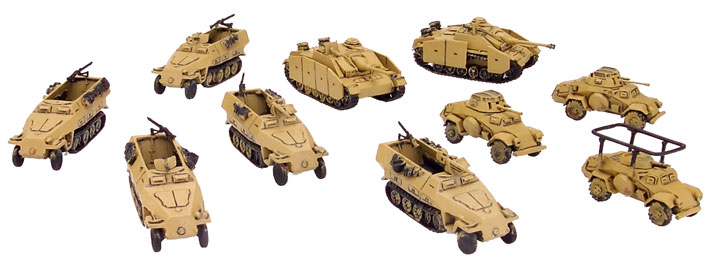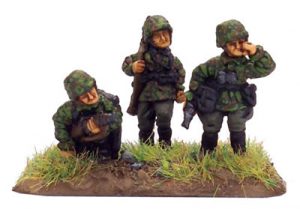Andrew is making good on his promise to freshen up his Red Banner Speedy Assaulters.
Wayne continues to spray up his StuGs
I’m working on my American Rifles.
Join the Battlefront team as we launch Bagration: Soviet
Andrew is making good on his promise to freshen up his Red Banner Speedy Assaulters.
Wayne continues to spray up his StuGs
I’m working on my American Rifles.

Whether you want to run a battle-hardened horde of Panzer IIIs or a crack team of T-34 Heroes, you can start putting them together over the weekend at Forces of War…
with Chris Townley
Over the past few weeks I’ve been thinking a lot about my terrain and what is useful for playing a Kursk (or even Eastern Front) themed game. Looking through what we have in the office as well as my collection at home I found that I had quite a few great options for creating themed tables.

Voronezh Front – Here the Soviets built extensive defences in layers. Time to dig out my Great War Trenchlines and Shattered Battlefields.
The Donets River – Rivers provide a natural defensive barrier and are a pain to deal with, making them great for a thematic game.
I put together a list of the terrain I thought might be useful. One of the graphic designers thought a spreadsheet looked a little dull so whipped up this PDF.
Check out the full range of Eastern Front terrain I’d find a place for on one of my tables here…
with Andrew Haught
This week just for fun we thought we come up with a arcade style mission using Borgwards in a new way. The main idea is you grab a friend or two and some tanks and you defend the supply route from an onslaught of German demolition carriers in a Space Invaders style game. This was put together especially for the launch and we thought we would release it as a Beta test for everyone to play around with.
For the mission click here…
For printable Borgwards and StuG Gs ckick here…
with Wayne Turner
I’ve decided to put together a StuG Assault Gun Company for the Kursk period from Ghost Panzers. By June 1943 many Assault Gun Battalions (Sturmgeschütz Abteilungen) had started to be equipped with the latest version of the StuG assault gun, the StuG III G armed with the long 7.5cm StuK40 gun. The 301. Panzer Battalion chosen as the theme unit in Ghost Panzers is a radio control unit that also contains Borgward demolition carriers, but by not taking the Borgward options it can also be used to represent any of the Assault Gun Companies or Batteries that served on the eastern front.
At Kursk in particular there are a number of Assault Gun Battalion or Brigades involved in the operations. Sturmgeschütz Abteilungen 904 (31 x StuG III) and 245 (22 x StuG III and 9 x StuH 42) served with XXXXVII Panzer Korps on the north side of the salient. Sturmgeschütz Abteilungen 177 (22 x StuG III and 9 x StuH 42) and 244 (22 x StuG III and 9 x StuH 42) served under command of XXXXI. Panzerkorps.
In addition a number of divisions had their own assault gun units. 78. Sturm Division had Sturmgeschütz Abteilung 189, Panzergrenadierdivision ‘Grossdeutchland’ had Sturmgeschütz Abteilung ‘Grossdeutchland’, 7. Infanteriedivision’s Panzerjäger Abteilung 7 contained one company equipped with StuG III, and 6. Infanteriedivision’s Panzerjäger Abteilung 6 contained one company equipped with StuG III.
To be a bit different I’m going to base my StuG force on 6. Infanteriedivision, representing the Sturmgeschütz Kompanie (Assault Gun Company) of Panzerjäger Abteilung 6 (6th Tank-hunter Detachment/Battalion). 6. Infanteriedivision fought in the middle of the 9thArmy’s attack on the north of the Kursk Salient and pushed as far as Olkhovatka during the battle along with the Panzertruppen. During the fighting the divisions also has the 1st and 2nd Companies of Heavy Panzer Battalion 505 (Tiger IE heavy tanks) and Panzerkompanie (Fkl) 312 attached.
My Force
13 pts StuG (Late) Assault Gun Company HQ, 1x StuG (late 7.5cm)
39 pts StuG (Late) Assault Gun Platoon, 3x StuG (late 7.5cm)
39 pts StuG (Late) Assault Gun Platoon, 3x StuG (late 7.5cm)
That’s 91 points. I’ll make this up to 100 points, but I haven’t decided what to spend my last 9 points on as yet.
with Andrew Haught
The battle lines have been drawn, the tanks have been fully serviced. It’s time for Firestorm: Kursk.
Firestorm Kursk
Firestorm is back and this time we are fighting around Kursk. Firestorm: Kursk recreates the two-pronged German attack around the town of Kursk in an effort to cut off the Soviet forces in the area. Of all the battles that occurred around Kursk, none quite compare to the battle of Prokhorovka, which ended up being one of the largest tank battles in military history.
The Campaign
This kit has everything you need to play a full Firestorm: Kursk campaign at your store or club. The campaign will consist of a series of Flames Of War games in which players attempt to capture areas from the enemy or recover those lost in earlier games. Each time a player attacks they place a marker on the map, once all the markers have been used the campaign is over and the side with the most victory points wins.
Battle of Prokhorovka
The 5th Guards Tank Army was one of the most powerful armoured forces fighting in the Battle of Kursk. It was formed in March 1943 from the brand-new 29th Tank Corps and the experienced 5th Guards Mechanised Corps, and gained the 18th Tank Corps as it moved to counterattack positions as the Germans attacked at Kursk. Once in position near Prokhorovka, it added the 2nd Tank Corps, 2nd Guards Tank Corps, and the 9th Airborne Division from the forces that had been delaying the German advance.
On 12 July 1943, this force of over 800 tanks attacked, including more than 500 T-34 tanks, throwing the Germans back in hectic, close-range battles. Phalanxes of tanks charged across the dry steppes, dodging the gullies that slashed the battlefield, crossing through the enemy formations to shoot at point-blank range into the flanks of their tanks. The hills and state farms that the Germans had captured the previous day were littered with burning tanks by nightfall.
Massive Tank Battles
Battle of Prokhorovka being one of the largest tank battles in Military history, makes it the perfect place to play large tank battles. We suggest you play at least 150 point forces with an emphasis on tanks formations. This is the perfect time to pull out every T-34 you have or that large Panther army you been trying to play but was too many points for a standard 100 point game. The 150 points is only a suggestion—got a large Tiger tank company and you want to fight at 200 points? Go for it! The more tanks, the better.
Unlike normal areas on the map, Prokhorovka is fought over a series of battles. So you can stage loads of large tank battles during your campaign. Each victory at Prokhorovka will earn the winning side a control token that is placed on the Prokhorovka Battle Track. Each control token on the Prokhorovka Battle Track is worth one victory point and is added to the totals on the Firestorm Kursk map once all battles have been played, so winning in Prokhorovka can decisive when calculating victory points at the end of the campaign.
You can also check out Firestorm: Stalingrad here…
Wayne settles in to airbrush his StuG battery, having brought an entire hobby room with him to the Studio this morning.

Mike’s KV-1s tanks are surely adding up as he assembles tanks at an alarming rate of knots.
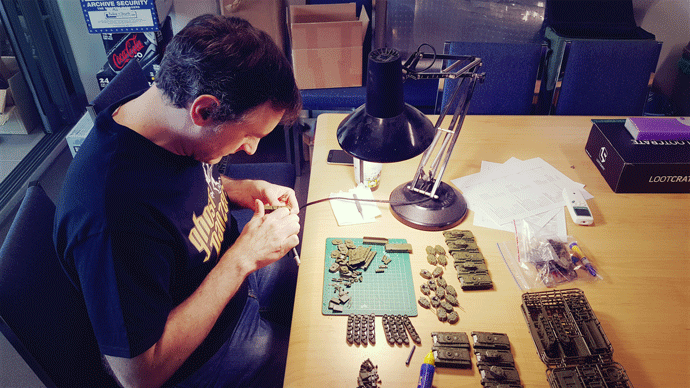
with J.C Von Winterbach
These two articles are taken from the Flames of War website and combined for this launch event. There is a link at the bottom of the page to the original articles with plenty more pictures.
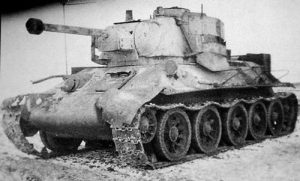
Notek Lights
All of the Notek lights were designed to be used under blackout restrictions so the indirect lighting/hooded light concept was essential for the front light when the standard/main lights couldn’t be used so to avoid being spotted from ground or aerial observers.

An ideal distance between vehicles meant two lights were visible. If only one was visible, the distance between two vehicles was too great while four visible looks meant the distance was too close.
Tactical Markings
The numbering system used on the Beutepanzers were the same as those of the normal German tanks being the three-digit or four-digit standard (1024, 895, 354, 48, 9, etc.)
But some of these Beutepanzers received a different numbering system called the E-Mark. This numbering system includes the letter “E”, followed by a roman numeral and a further two-digit or a three-digit number. On most assumptions the letter “E” indicates Erbeutet (Captured).
Position of Markings
The areas where these identification marks were located where mainly on the frontal, sides and rear panels of the turret and hull. The turret hatches and the barrel of the main gun, as well as under the barrel of the main gun, and track guards were also used as locations for identification marks. These signs were usually painted considerably large.
Other Markings
Some of the markings found to be painted on the Beutepanzers ranged from the Balkenkreuz, Swastikas, Divisional or Sub-Divisional Insignias, individual inscriptions or simply a German flag.
Among the individual inscriptions found on the Beutepanzer were the names of Soldiers (Emil, Karl, Radetzski, Jaeger, etc.), the names of wild animals (Tiger, Leopard, etc.), the names of municipals or provinces (Dantzig, Saar, etc.).
Kill Rings (Victory Rings) where also paint onto the barrel of the main gun to show how many victories the Beutepanzer & its crew had accomplished.
Tank Colors
Beutepanzers saw just as much change to their paint schemes as the rest of the German Armored Core due to the different periods, areas of operation, seasons and special needs. For starters, a lot of the Beutepanzers were repainted in the German Panzer Grey color, but as times went forward, these tanks also changed as the German tanks changed. From the beginning of 1943 they began to use camouflage patterns (Please refer to Art of War II for a complete list of German Camouflage painting schemes throughout the periods) on the Beutepanzer. These tanks also followed the winter camouflage paint scheme. But records & photos also show that a of of these tanks were left with their original colour scheme and went unchanged, except for their identification markings.
You can read J.C’s Modifications article and see more pictures here…
And more markings pictures here…
with Gareth Richards
Up next was the camo scheme, taking from the painting guide at the back of Ghost Panzer book applied Army Green and applied the camo pattern, this is still a weak point of my painting and something that hopefully will improve as I paint more tanks. In the cervices I worked in Panzer Grey mixed with black to add working dirt, this was also drybrushed onto the barrel and the wheels to add more dirt and weathering to the model.
Before applying decals which I will do as batch run for the entire army I added on a drybrush of Dry Dust to the edges of the Ferdinand to add a bit of pop colour to help it lift from the table.
The Ferdinand, table-ready (barring decals and battle damage) is ready for its first game. I will be starting on the Panthers this week and then onto the Panzers, aiming to have them completed and ready for decals and weathering and then onto to some games the following week.
with Casey Davies
Much like Soviets, over the years I’ve painted a vast amount of Waffen SS, Initially I built this as part of a 600 point staff army (insert link to article here)
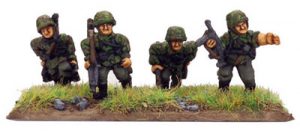
Going back to Kursk is a chance to dust these models off again and have a few games. The largest part of my painted collection is a Gepanzerte Panzergrenadierkompanie.